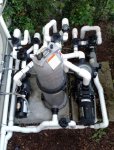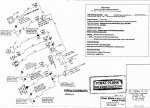Thanks for all of the help. Here's my pool equipment:

In answer to your questions:
All of the piping is 2"
In terms of the suction, there is a pool and spa suction, and the pool suction side also has a branch for the cleaner return, but that is left closed. The spa suction only opens (automatically) when the spa is turned on.
The pool level is 1.5' above ground level, with a trough of an infinity edge at ground level. The filter gauge is 45" high, so 37" above the main pool water level.
Service factor 1.10 = 2.20 total motor HP
Are the pressures in low speed (7-8 PSI) without solar too high as well? All of the water, whether solar or not, goes through that spring loaded valve. Do I need to change that check valve?
Pool Clown, I understand what you say about the inlet size and thickness affecting its fit into the diffuser. Currently I have the diffusers for both the smaller and larger impellers.
It seems the consensus that the plumbing is at least part of the problem. Currently I have the bypass valve from the pump directly to the SWG and return turned off, so all of the water goes through that cheap spring valve, up to the solar panels if on, to the gas heater, then finally past the bypass to the SWG and return. I opened that valve completely to see the pressures with a bypass option around the spring valve, and (with 2 HP impeller) the pressures went (without solar) from:
high speed: 22 -> 18
low speed: 7 -> 6
I think all of the valves in my system are the good Jandy flap ones that minimize head loss. There is this in the pool return line:

and I'm not sure if that could be a valve of some sort, but the guys who did the pool are very well respected, do lots of residential and commercial pool, whereas the guys who put the solar panel (and maybe that spring valve) weren't good.
What do you guys think?
And do you agree that if I find the minimal HP impeller that I need, and I just use the pump in high speed for solar on and low speed otherwise, that my 2-speed pump is efficient enough, and that a variable-speed pump isn't necessary?






